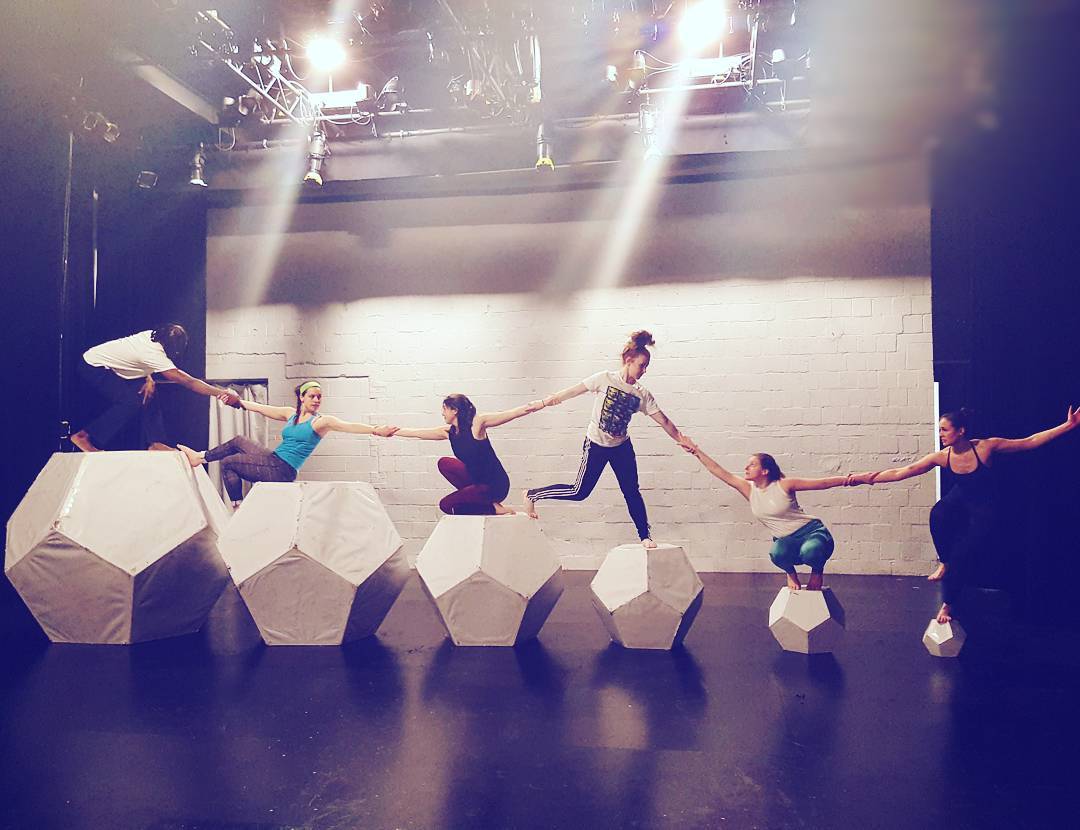This weekend, ReVision dance company will perform its latest full-length work, Propelling Voice at Dance Place in Washington, DC. Since its founding in 2011, ReVision has been a stronghold of Dance Place’s artistic and educational programming. Artistic Director Shannon Quinn grew ReVision atop the foundation built by Carla & Company, a professional ensemble that was dedicated to building new audiences for dance through community performances under the direction of Carla Perlo from 1991-2010.
“I danced with Carla & Company for about 5 years,” Quinn says. “In 2010, Carla said she was going to step down from the company and asked if I wanted to keep it going, so I became the Co-Artistic Director. We had our first audition for ReVision in June 2011 and hit the ground running.”
ReVision’s mission furthers that of its predecessor: in addition to artistic excellence, a central focus of the company is its educational outreach initiative. The dancers regularly perform and conduct workshops in a range of contexts, including elementary schools and centers for people with intellectual and developmental disabilities. Their underlying approach to dance education is grounded in the philosophy that all people, regardless of ability, size, age or experience, can dance and explore their own creative ideas. Quinn serves as the Education Director at Dance Place and works to integrate her artistic work into her role as a teacher and coordinator for hundreds of outreach and on-site classes for children.
The company’s aesthetic incorporates high-energy athleticism and grace into tightly coordinated movement. In Propelling Voice, the dancers’ fluid collective motion collides with the angular geometric environment of their set to create a dynamic choreographic flow. The project’s co-director Ben Levine envisioned a series of six dodecahedrons ranging from one to six feet in height, which he constructed initially for a performance in July 2016. Levine and Quinn began experimenting with the idea of incorporating the structures into a piece about building community and thus Propelling Voice assumed a new spatial and symbolic dimension. Each “dodec,” as they are nicknamed, facilitates a unique flavor of movement and shape as bodies jump onto, lean into, climb over, carry and dance around them. The dancers interact with the set pieces in six distinct orientations over the course of the piece, each section corresponding to a different theme on the subject of community.
Quinn explained the history of the work: “Propelling Voice premiered in February of 2016 at Dance Place. I was really interested in hearing the perspective of youth, particularly teens in an urban setting, on what community means to them and what support they feel like they have.” The choreographer began developing a script by interviewing Kamynah West, a teenage Junior Staff member at Dance Place, whose narrative initially formed the basis for the piece’s format and focus when it premiered. In January 2017, the company traveled to Pretoria, South Africa for a return engagement with the Tiqwa School to teach workshops for children with developmental disabilities. They spent a week with Usuthu Arts Productions and began experimenting with extending the subject of Propelling Voice to a broader sense of community across generations and nationalities.
“I realized that the piece had such a larger meaning beyond just the perspective of youth, particularly today in our political climate,” Quinn said. She wanted to dissect community in the macro- and microscopic sense as well as explore tensions and conflict that exist even when people are brought together around a common passion such as the arts. “South Africa was our wake-up moment. We paired people from South Africa with people from America to answer six questions about community from two different national perspectives.When we came back to DC, we used the same format and engaged different ages, races and backgrounds in group discussions.” The company performed their second incarnation of Propelling Voice at the South African State Theater with local dance students at the end of their January residency.
Alison Talvacchio, Dance Place’s Box Office Manager and a company member of ReVision, reflected on the process of translating concepts they developed in South Africa to audiences back home. “At first I was worried about the text we created in South Africa relating to people in DC – but everyone worries about the same things, everyone has the same the needs and wants, we just sound a little different asking.”
While preparing for their spring production of Propelling Voice back in the United States, Quinn invited members of the Dance Place staff, parents, children involved in the Energizers Afterschool Club and Junior Staff and board members to exchange ideas on individuality, self-realization, new environments, community support, judgment and stereotypes, self-expression, and risk-taking. Their conversations were raw material for the script that now weaves throughout the piece. Community and company members participate in delivering these lines during transitional moments between each of the six sections of dance.
Brenna Dames, Dance Place’s Education Associate and a company apprentice with ReVision, was inspired by the trust and bravery she observed amongst community members in South Africa and at Dance Place who were willing to take risks on jumping and falling off of the dodecs. “Everyone was super eager to to collaborate with us and it was really exciting to see how willing they were to work together to create something that we hadn’t done before.” The six twelve-sided wooden structures form the physical environment in which the dancers explore the meaning of the script’s unanswerable questions with their bodies. They free fall into each other’s arms, launch into handstands and extend their limbs while suspended in mid-air, using one another and the dodecs for leverage.
Talvacchio explained her favorite moment in the piece. “There’s a short section in the middle after various movement is happening all over the stage, when the dancers collect in a small circle and begin to fall into or lean on one another. It’s a lovely continuous exchange of weight and is visually pleasing but also symbolic for me of the closeness and trust in this little company of ours.”
Through their shared exertion, collaboration, risk-taking, mutual trust and creative experimentation, the performers use dance to embody the ingredients necessary for forming a strong, resilient and nurturing community. Dames noted that the broad focus on community and diversity of participants makes Propelling Voice accessible for all audiences. “Everyone can take something away from the piece. The people on stage are all of different ages and backgrounds, so regardless you’re going to relate to someone or something that’s said. The text is great because it helps give insight to the piece without spoon-feeding the audience. The movement is super athletic, so the piece just keeps going and going.”
And the questions just keep coming and coming. As Quinn noted, Propelling Voice is just the beginning of a long, perhaps never-ending conversation about how individuals define themselves and navigate their social environments. Questions spoken in the show such as “If I take time to better myself, will I be able to better serve my community?” and “How can I find compassion instead of resorting to hatred?” are catalysts for reflection on both a personal and global scale. The speakers touch upon themes of faith, family, art, stability, choice and communication, expressing at the outset of the work that “we still have many questions.” Though they may have multifaceted and ever-shifting answers, the questions introduced in Propelling Voice are crucial inquiries to be making in our current political climate. As Quinn and her ensemble show us, finding a supportive community can begin with exploring the most fundamental element of our shared humanity: our physical bodies.
When asked what she had discovered about building community through dance while working with ReVision, Talvaccio responded: “Pushing yourself to work harder, jump higher, run faster, get tired and get bruised is very, very rewarding. It’s only possible with a group of people who are working towards the same ends and who you trust to catch you if you fall.”
Article by Rebecca Cohen
Header photo by Alison Talvacchio
Credits for this weekend’s show include;
Company dancers: Elizabeth Zinni, Olivia Landrum, Elizabeth Malone, Jillian Peterson, Matina Phillips, Alison Talvacchio, Triana Brown, Nkosinathi “Natty” Mncube
Community dancers: Sened Brhane, Winta Brhane, Triana Brown, Brenna Dames, Jannes Gibson, Ben Levine, Richard Pilkinton, Hermione Rhones, Denise Rollins, Rodjnay Scott, Shomari Stevens, Mya Stuckey & Hannah Weissler
Lighting design by Annie Choudhury

